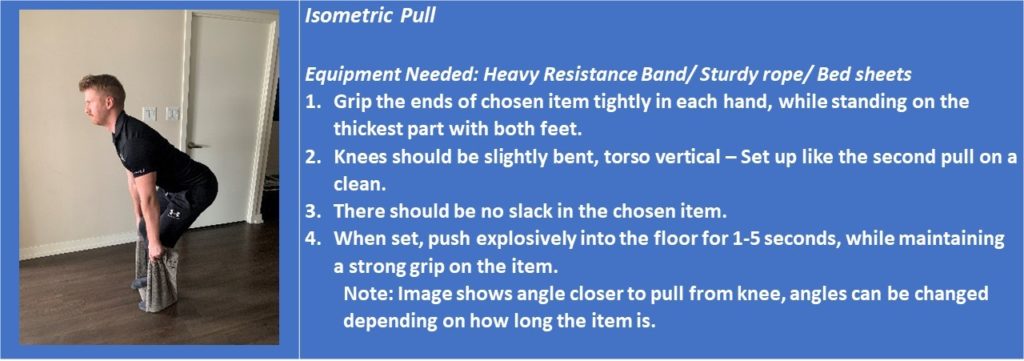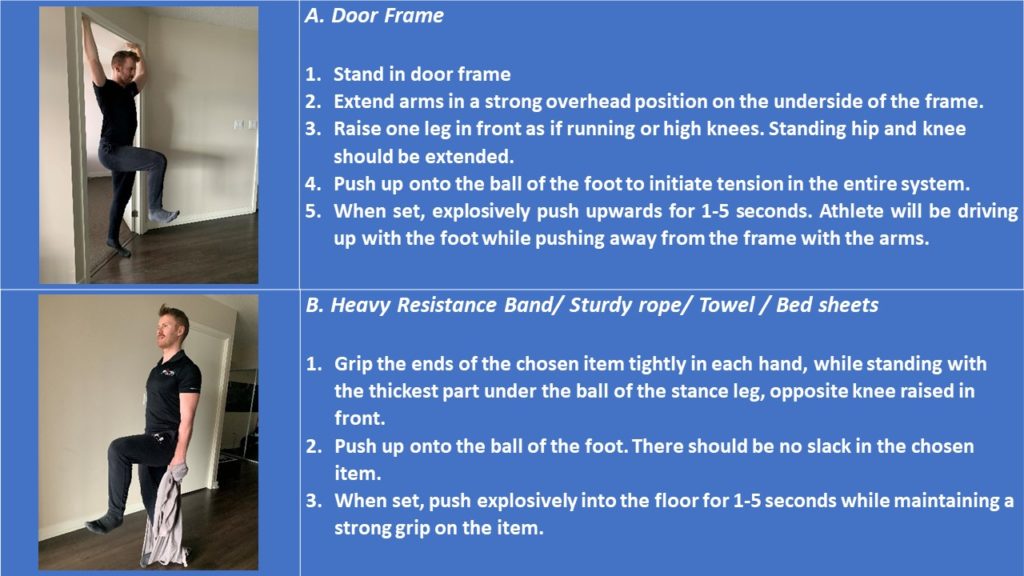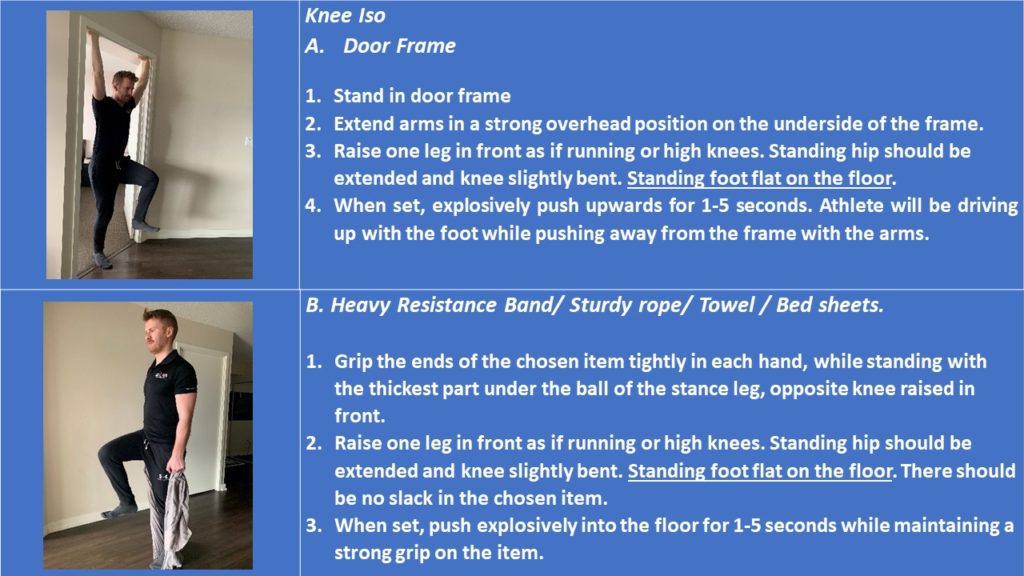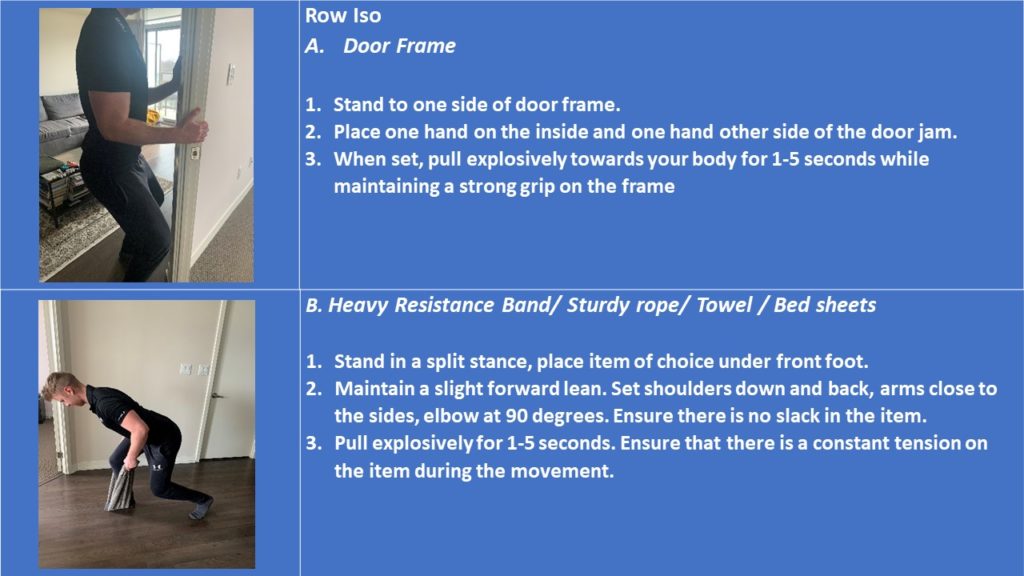Explosive Isometrics for Sports Performance: Going Nowhere… Fast!

Abstract
Explosive isometrics can be a valuable addition to a training program seeking to develop maximal strength and power. This article provides guidelines for using isometric training in both a high-performance setting, as well as providing alternative options when equipment is limited.
Key Words; Isometrics, Strength, Power, limited equipment
Introduction
A focus on specific Isometric training may not be a method used as often as concentric and eccentric training. It is admittedly less glamorous, and harder to quantify compared to squatting 500lbs or bench pressing 300lbs, but it can have similar benefits. It may be even more sport specific than traditional barbell training. In most sport movements all three types of actions are present to varying degrees – isometric contractions take place in the transition between concentric and eccentric contractions.
- A concentric contraction causes muscles to shorten, thereby generating force. For example, driving up out of the squat movement.
- Eccentric actions cause muscles to elongate in response to a greater opposing force. For example, lowering to the bottom position of a squat.
- Isometric contractions generate force without changing the length of the muscle. For example, transitioning from down to up in a squat movement.
This article discusses the use of isometric training for developing important physical qualities as well as highlighting that minimal equipment is required for these exercises, provided there is maximal intent.
Explosive Isometrics
Explosive isometrics refer to a movement where the athlete pushes or pulls into an immovable object with as much force as possible for a specified amount of time (typically 1-5 seconds). These isometric actions can be used to develop, and measure maximal strength or power. Longer duration 3 second holds allow the athlete to continue to generate maximal force and are more beneficial for maximal strength. Focusing on generating force as quickly as possible is more beneficial for power or rate of force development. In addition to developing these qualities, there are other advantages of isometric training.
- Time efficient – if done properly, with focused intent, similar strength benefits may be possible in far less time compared to performing exercises in a traditional manner.
- Increases in strength without relative increases in muscle size which may be useful for sports involving weight classes.
- While it can be fatiguing when done properly, energy expenditure is typically less than with traditional dynamic exercise training.
- Minimal equipment required.
In a high-performance setting, the force generated can be measured using force plates or strain gauges. These are necessary to monitor changes and improvements in isometric strength levels. However, in a typical sport setting the athlete can benefit massively from being accountable and providing maximal intent in each repetition. One very important point to note is that the strength improvements typically occur at, or close to the specific angle that is used during the exercise. When looking at general strength exercises, there will primarily be carry over to the general movement itself. See below for examples.
Isometric Mid-Thigh Pull (IMTP)
- Set up a heavy immovable barbell, or locked smith machine at mid-thigh position.
- Knees should be slightly bent, torso vertical – Set up like the second pull on a clean.
- Grip the bar tightly.
- When set, push explosively into the floor for 1-5 seconds, while maintaining a strong grip on the bar.
Alex Natera, an expert in the area, has suggested the below positions for specifically improving running performance, which closely mimic the ankle, knee, and hip actions involved during maximal sprinting.
Ankle Iso
- Set up a heavy unmovable barbell or locked Smith Machine just above standing shoulder height.
- Stand under the bar.
- Raise one leg in front as if running or high knees. Standing hip and knee should be extended.
- Push up onto the ball of the foot so that shoulders are pressed gently against the bar.
- When set, push explosively into the barbell for 1-5 seconds.
Knee Iso
- Set up a heavy unmovable barbell or Smith Machine as if you were doing a squat.
- Set up under the barbell.
- Raise one leg in front as if running or high knees. Maintain slight flexion in the standing leg, foot flat on the floor, shoulders should be pressed gently against the bar.
- When set, push explosively into the barbell as hard as you can for 1-5 seconds.
It is suggested that using these specific key positions is more beneficial to sporting performance than the general IMTP movement discussed above. Coaches of throwing sports, swimming, rowing, etc. may want to identify specific angles where rapid force is required to perform well in the sport (e.g. the catch in a rowing stroke) and create their own specific explosive isometric holds.
Explosive Isometrics with limited equipment
When equipment is limited, explosive isometrics can be a valuable addition to improve strength and power. Below are variations using simple gym equipment or everyday items that can be very effective.





Gary currently works with National Team Athletics athletes who train out of the Athletics Canada’s Eastern Hub at York University.
The above information is for athletes involved in individually prescribed training programs directed by certified and qualified professionals. Professionals and athletes acting on the information, instruction and programming do so on the condition that it will not be the basis of any claim, demand, or cause for action. Individuals acting on the information presented do so voluntarily at their own risk and are responsible for ensuring their physical environment and location is free from hazards, inadequate equipment, or other item or factor that may cause harm.
Resources
Verkhoshansky Y, Siff MC. Supertraining. Verkhoshansky SSTM; 2009.
Modern Speed Training: Q&A with Alex Natera on Isometrics for Running Performance. Natera, A. https://www.just-fly-sports.com/modern-speed-training-alex-natera/
Lum D, Barbosa TM. Brief review: effects of isometric strength training on strength and dynamic performance. International journal of sports medicine. 2019 May;40(06):363-75.
Oranchuk DJ, Storey AG, Nelson AR, Cronin JB. Isometric training and long‐term adaptations: Effects of muscle length, intensity, and intent: A systematic review. Scandinavian journal of medicine & science in sports. 2019 Apr;29(4):484-503.






